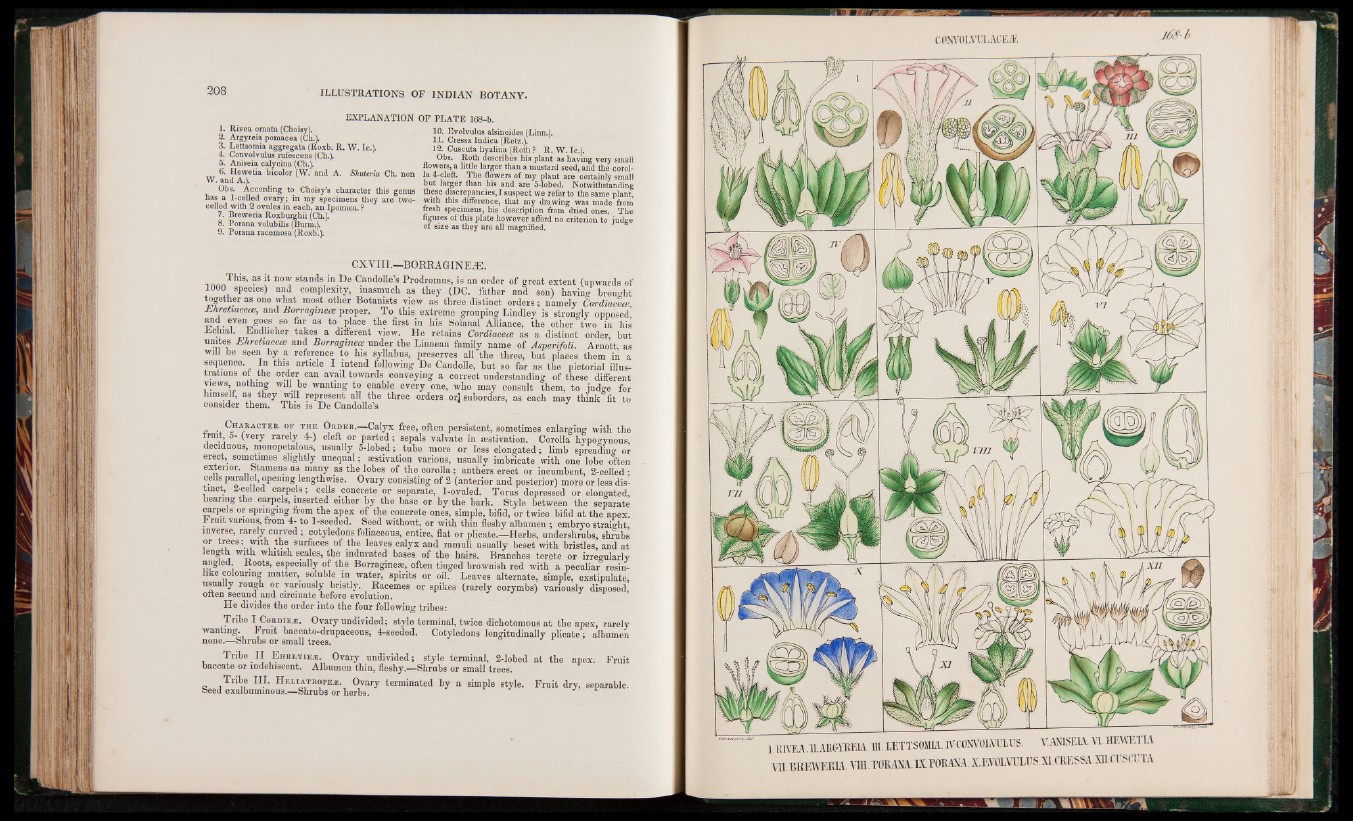
EXPLANATION OF PLATE 168-b.
1. Rivea omata (Choisyl
2. Argyreia pomacea (Cn.).
3. Lettsomia aggregata (Roxb. R. W. Ic.).
4. Convolvulus rufescens (Ch.).
5. Aniseia calycina (Ch.).
6. Hewetia bicolor (W. and A. Shuteria Ch. non
W. and AÀ
Obs. According to Choisy’s character this genus
has a 1-celled ovary ; in my specimens they are two-
celled with 2 ovules in each, an Ipomoea. ?
7. Breweria Roxburghii (Ch.).
8. Porana volubilis (Burm.).
9. Porana racemosa (Roxb.).
10. Evolvulus alsinoides (Linn.).
11. Cressa Indica (Retz.).
12. Cuscuta hyalina (Roth ? R. W. Ic.).
Obs. Roth describes his plant as having very small
flowers, a little larger than a mustard seed, and the corolla
4-cleft. The flowers of my plant are certainly small
but larger than his and are 5-lobed. Notwithstanding
these discrepancies, I suspect we refer to the same plant,
with this difference, that my drawing was made from
fresh specimens, his description from dried ones. The
figures of this plate however afford no criterion to judge
of size as they are all magnified.
CXVIII.—BORRAGINEiE.
noIf stands in De Candolle’s Prodromus, is an order of great extent (upwards of
1000 species) and complexity, inasmuch as they (DC. father and son) having brought
together as one what most other Botanists view as three distinct orders; namely Cordiaceae
Ehretiacete, and Borraginece proper. To this extreme grouping Lindley is stronglv opposed’
and even goes so far as to place the first in his Solanal Alliance, the other t'wo in his
Rcnial. Rndhcher takes a different view. He retains Cordiacece as a distinct order, but
unites Ehretiacece and Borraginece under the Linnean family name of Asperifoli. Arnott, as
will be seen by a reference to his syllabus, preserves all the three, but places them in a
sequence. In this article I intend following De Candolle, but so far as the pictorial illus-
t. ions or the order can avail towards conveying a correct understanding of these different
views, nothing will be wanting to enable every one, who may consult them, to judge for
himself, as they will represent all the three orders or] suborders, as each may think fit to
consider them. This is De Candolle’s
. .. C h a r a c t e r of t h e O r d e r .—Calyx free, often persistent, sometimes enlarging with the
truit, 5- (very rarely 4-) cleft or parted; sepals valvate in aestivation. Corolla hypogynous
deciduous, monopetalous, usually 5-lobed; tube more or less elongated; limb spreading or
erect, sometimes slightly unequal; aestivation various, usually imbricate with one lobe often
exterior. Stamens as many as the lobes of the corolla; anthers erect or incumbent, 2-celled •
cells parallel, opening lengthwise. Ovary consisting of 2 (anterior and posterior) more or less distinct,
2-celled carpels; cells concrete or separate, I-ovnled. Torus depressed or elongated,
bearing the carpels, inserted either by the base or by the bark. Style between the separate
carpels or springing from the apex of the concrete ones, simple, bifid, or twice bifid at the apex.
. rul’ varI°u8, from 4- to 1-seeded. Seed without, or with thin fleshy albumen ; embryo straight,
inverse, rarely curved; cotyledons foliaceous, entire, flat or plicate.—Herbs, undershrubs, shrubs
or trees; with the surfaces of the leaves calyx and ramuli usually beset with bristles, and at
ength with whitish scales, the indurated bases of the hairs. Branches terete or irregularly
angled. Roots, especially of the Borraginese, often tinged brownish red with a peculiar resinlike
colouring matter, soluble in water, spirits or oil. Leaves alternate, simple, exstipulate,
usually rough or variously bristly. Racemes or spikes (rarely corymbs) variously disposed,
often secund and circinate before evolution.
He divides the order into the four following tribes:
Tribe I CoRDiEiE. Ovary undivided; style terminal, twice dichotomous at the apex, rarely
wanting. Fruit baccato-drupaceous, 4-seeded. Cotyledons longitudinally plicate; albumen
none.—Shrubs or small trees.
Tribe II E h r e t i e * . Ovary undivided; style terminal, 2-lobed at the apex. Fruit
baccate or mdehiscent. Albumen thin, fleshy.—Shrubs or small trees.
c WM HI Helia-tbopeje. Ovary terminated by a simple style. Fruit dry, separable.
Seed exalbuminous.—Shrubs or herbs.
CONVOLVUI, ACEÆ j 6 8 - b
1 RIVEA.11.ABBYEE1A 111. LETTSOMIA. IVCONVOLVULUS. V.ANISEIA. VI. HEWETIA
VllTStEWEMA. Vlll.TORANA. IX. P0KAM.X.EV0LVÜLUS.XI.CRESSA.X1L CUSCUTA